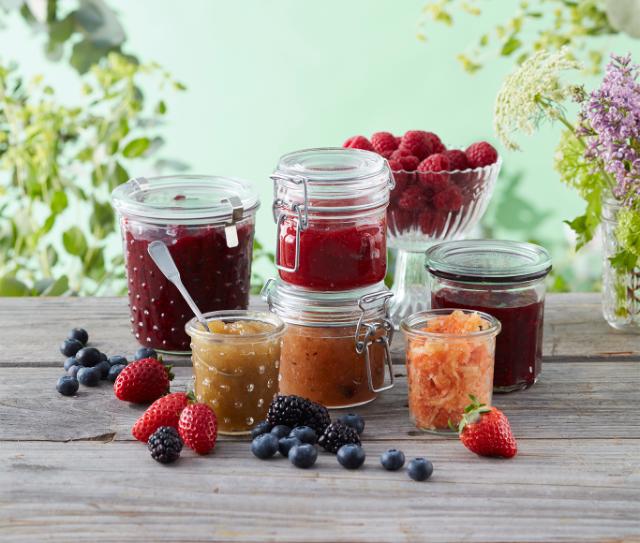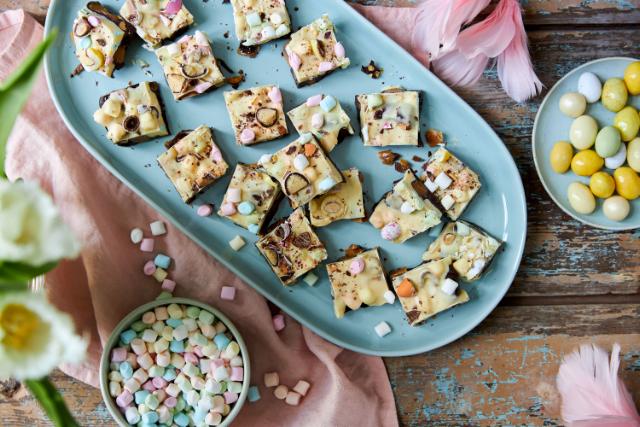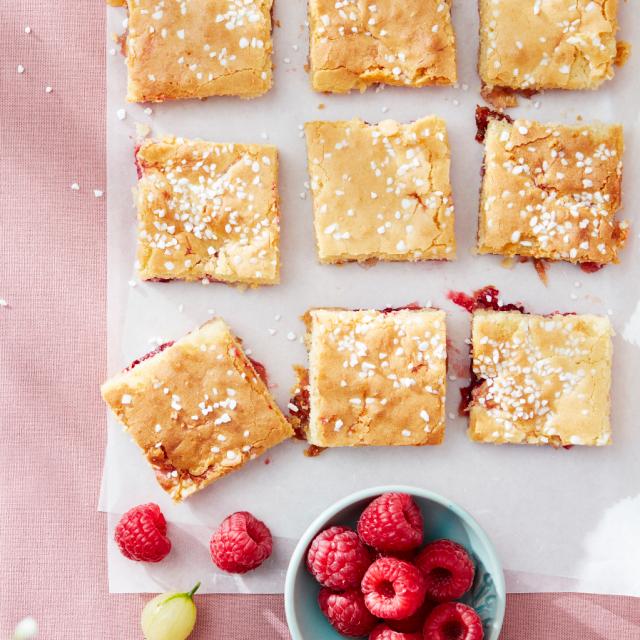
Jam Hotline
Here you can find answers to common questions about making jam. You will also find useful tips and inspiring ideas for flavourings.
My jam is too runny. What should I do?
You may have used fruit that’s low in pectin, or your may not have used enough sugar. Boil the jam hard for a couple of minutes to reduce it slightly, or add Melatin (powdered pectin sold in small sachets in the supermarket) and re-boil the jam, following the packet instructions.
My jam is too firm. What should I do?
If your jam turns out too firm, dilute it with a little water and boil it again.
How do I get my jam the right consistency?
To test your jam's consistency, put a saucer in the fridge before starting to make the jam. When the jam is ready, put a spoonful of jam onto the cold saucer and put it in the fridge. When the jam has cooled, trail a spoon through it to check the consistency. If you’re satisfied with the consistency, pour the jam into jars and seal them tightly.
Why does the fruit float to the top?
The jam may need to boil for longer. The fruit/berries contain air which needs to boil away.
What to do: Allow the hot jam to cool in the saucepan for 15 minutes. Stir occasionally to distribute the fruit evenly. You can also turn the filled jam jars occasionally while cooling.
Why has my cordial/jam fermented?
This can happen if the jam contains too little sugar, was not stored in a cool enough place, or if some of the fruit in the jam was bad. Always wash and pick through your fruit and berries thoroughly. A single bad berry can ruin the entire batch of jam. Fermentation can also be caused by using poorly cleaned jars or bottles, or by not skimming off the scum properly.
Why has my cordial/jam gone mouldy?
You may have used too little sugar, mouldy or bad fruit, or fruit that has not been adequately cleaned. Mould can also be caused by inadequately sterilised jars, or by storing the jars in warm and moist conditions. When your jam or marmalade is ready, it’s important to quickly pour it into the jars, filling them right to the top. Always throw away mouldy preserves. Never eat them, since certain moulds can form toxins.
Why has my cordial turned to jelly?
The berries you used weren't ripe enough for making cordial. They contained too much pectin. Put the bottles in warm water until the cordial dissolves. Then boil the cordial with 3-4 dl of water per litre of cordial and add 1 gram of preservative per litre of cordial.
Why won’t my jelly set?
This can be caused by insufficient boiling time, too little sugar or over-ripe berries, or the fact that you have use jam sugar instead of Jelly sugar multi which we recommend for jelly.
Can I make Jelly with jam sugar?
We don’t recommend this since we can’t guarantee the result. Sometimes it works, sometimes it doesn’t. Instead of Jelly, you could end up with a thick, grainy paste due to the pectin interacting with the acid in the berries. If you’re only making a small amount of Jelly, we recommend Jelly Sugar Multi. Use one package for 4 dl of raw fruit juice. If you're making larger amounts, it's more economical to use ordinary sugar. In that case, use 1 kg sugar per litre of raw fruit juice and boil for 10-15 minutes. Perform a gel test. Pour a teaspoon of liquid onto a chilled saucer and refrigerate until cold.
Can I use jam sugar to make apple sauce?
No, you'll end up with a very firm apple jam instead of sauce. Ordinary granulated sugar is best for apple sauce.
Can I use jam sugar for making uncooked jam?
No, jam sugar has to boil for at least two minutes for the pectin to dissolve into the jam.

My recipe says to layer the berries with the sugar and leave them to stand overnight. Can I do this with jam sugar too?
Yes. Jam sugar works perfectly in most jam recipes that specify ordinary granulated sugar.
My recipe says to boil the berries and water for a certain number of minutes before adding the sugar. Will this work with jam sugar too?
Yes. There’s no difference between jam sugar and ordinary granulated sugar in this case.
My jam sugar has passed its sell-by date. Can I still use it?
That depends on how old the Jam Sugar is. You should be able to use it up to a year past its sell-by date, but any longer and we can't guarantee that the preservative will still be active, so the jam will need to be stored in the fridge or freezer. The pectin may also deteriorate over time, which could affect the jam's consistency.
What does 1+3 mean?
1+3 is a small packet of jam sugar for making low-sugar jam. The pack contains enough for 1 kg or berries or fruit. 1 stands for one part sugar and 3 stands for three parts fruit. This jam sugar gives the jam a good consistency even with a low sugar content.
What does the information table on the Jam Sugar bag mean?
It's easy. Read the table from left to right. The first column is the recipe for classic jam, the next column is for low-sugar jam, and the column furthest to the right is a recipe for citrus marmalade.
There are brown specs in my jam sugar. What are they?
Brown specks may form in Jam Sugar that has been standing in the larder for a long time. They are caused by a reaction between the citric acid and the sugar, and are nothing to worry about. They will not change the Jam Sugar’s other properties, and won't be visible in the finished jam.
Storage
Jam made with our Jam Sugar can be stored at normal room temperature and will keep for at least a year. However, its colour and flavour is best preserved by storing it in a cool, dark place. Jam without preservatives or uncooked jam should be stored in the freezer.
Hygiene
Hygiene is crucial to a jam’s shelf life. Jars and lids should be carefully cleaned and sterilised before use. Fill the jars right up to the top and screw the lids on immediately. Make sure you skim any scum off the jam before pouring it into the jars. All microorganisms that can cause mould are transmitted through the air and in the scum on the jam. Also, you should only use fruit and berries of consistently high quality. A single bad berry can reduce the shelf life of the whole batch of jam.
Tips
Sugar is vital for taste, consistency and shelf life.
Jelly Sugar Multi gives jellies, cake glazes and many desserts the right consistency. To make black currant jelly, for example, use 1 dl of jelly sugar for each dl of fruit juice. Jelly sugar can be used with water, juice, cordial, wine or milk products. Jelly Sugar Multi replaces gelatine. It is a completely vegetable-derived product made from sugar and carob bean gum.
Jam Sugar contains everything you need to make perfect jam. Granulated sugar and citric acid give the jam a delicious taste and attractive colour, pectin provides the right consistency and potassium sorbate ensures a long shelf life even when stored at room temperature. Jam Sugar 1+3 is a special variant of jam sugar for making low-sugar jam.
Pectin is a natural gelling agent found naturally in varying quantities in fruit and berries. As a general guideline, the sourer the fruit, the more pectin it contains. Also, unripe fruits and berries contain more pectin than unripe ones.
Frozen berries are used in the same way as fresh berries. Although defrosted berries appear more watery, the liquid released from them during defrosting was also present in the fresh berries.
Suggested flavourings
• Add a cinnamon stick or a couple of star anise pods to the jam while it’s boiling.
• Add a small piece of fresh ginger when boiling rhubarb jam.
• Add whole or chopped almonds to the jam for a luxurious touch.
• Add a couple of fresh thyme or rosemary sprigs when making apple sauce or apple jam. Thyme also goes very well with plums.
• Use fresh summer herbs to flavour pickles or jams. Add them at the end of the cooking time to preserve their flavour and shape.
• A few lavender blossoms make a wonderful flavouring for strawberry jam.
• Nuts taste particularly good in citrus marmalades. Raisins add sweetness and character to tart tasting jams.
• For a delicious variation, stir 50-100 g grated dark chocolate into your jam.
• Add a couple of dessertspoons of brandy or whisky to jam or marmalade for a festive touch. Calvados tastes great in apple sauce or apple jam.
• Wine and vinegar add a perfect twist to the jam’s flavour. White wine or white vinegar make a lighter coloured jam, while red wine or vinegar make a lovely dark jam.
• Nuts taste particularly good in citrus marmalades. Raisins add sweetness and character to tart tasting jams.
Would you like more information about Nordic Sugar and our products and services?

Easter treats
Here you can find pastries, sweets and desserts for a very happy Easter weekend.

Delicious chocolate
Mmm! What could be better than a rich, sumptuous chocolate cake to lift the spirits – either as an indulgent treat or to round off a meal.

Pancakes
Children love pancakes. And so do adults. Pancakes make the perfect snack, picnic food, brunch or dessert – and they are so easy to vary with a wide variety of accompaniments. Why not try drizzling with a little syrup.

Baking in a roasting pan
Baking in a roasting pan is simple and practical – and above all, it produces large quantities. Ideal if you're having a party or taking a cake to work.

Time for citrus
Is there anything better than to start the morning with homemade marmalade on your toast. Let the season's citrus fruits inspire you. If you use our Jam Sugar, you can make your own marmalade in minutes.

Friday chill out
Friday is perhaps the very best day of the week, and a Friday chill out is the best way to celebrate the end of the working week. Re-charge your batteries ready for the weekend by relaxing on the sofa with the television, family, friends and something that little bit special to eat. We have the recipes for your chill out evening!